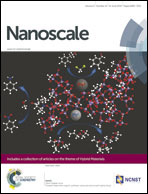Aluminum based sulfide solid lithium ionic conductors for all solid state batteries†
Abstract
The present work focuses on the synthesis of lithium ionic conductors based on a Li2S–Al2S3–GeS–P2S5 system due to the high ionic conductivity exhibited by the constituents of this system. Mechanical milling for a short duration and a single step heat treatment at a moderate temperature of 550 °C resulted in crystalline powders with high lithium ionic conductivity at room temperature that are comparable to the organic liquid electrolytes. The effect of various aluminum to germanium ratios was studied. Among the samples containing Al : Ge, the ratio of 30 : 70 was found to show high ionic conductivities of 1.7 × 10−3 S cm−1 at 25 °C and ∼6 × 10−3 S cm−1 at 100 °C equivalent. The activation energy of this material was significantly less (Ea = 17 kJ mol−1), which can be considered to be the best value among solid electrolytes. The electrochemical stability was analyzed using cyclic voltammetry between −0.3 and 5.0 V and it was found that the voltammetric profile was smooth without any additional current response, due to electrolyte decomposition, or any other side reaction, except a pair of lithium deposition and stripping peaks.


 Please wait while we load your content...
Please wait while we load your content...